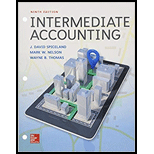
Discontinued operations; disposal in subsequent year
• LO4–4
Kandon Enterprises, Inc., has two operating divisions; one manufactures machinery and the other breeds and sells horses. Both divisions are considered separate components as defined by generally accepted accounting principles. The horse division has been unprofitable, and on November 15, 2018, Kandon adopted a formal plan to sell the division. The sale was completed on April 30, 2019. At December 31, 2018, the component was considered held for sale.
On December 31, 2018, the company’s fiscal year-end, the book value of the assets of the horse division was $250,000. On that date, the fair value of the assets, less costs to sell, was $200,000. The before-tax loss from operations of the division for the year was $140,000. The company’s effective tax rate is 40%. The after-tax income from continuing operations for 2018 was $400,000.
Required:
1. Prepare a partial income statement for 2018 beginning with income from continuing operations. Ignore EPS disclosures.
2. Repeat requirement 1 assuming that the estimated net fair value of the horse division’s assets was $400,000, instead of $200,000.
Want to see the full answer?
Check out a sample textbook solution
Chapter 4 Solutions
INTERMEDIATE ACCOUNTING(LL)-W/CONNECT
- What is the overall contribution margin ratio?arrow_forwardWestlake Components planned to use $95 of material per unit but actually used $92 of material per unit. The company planned to produce 1,800 units but actually produced 1,400 units. What is the sales-volume variance?arrow_forwardPlease provide the answer to this general accounting question with proper steps.arrow_forward
- Navarro Enterprises has a beginning retained earnings balance of $78,000. Net income for the year is $22,000, and cash dividends paid during the year amount to $12,500. What will be the ending retained earnings balance? a. $78,000 b. $87,500 c. $100,000 d. $65,500arrow_forwardDetermine the pre-paid insurance value for portman enterprises as this is the one unknown item.arrow_forwardCornell Corporation plans to generate $960,000 of sales revenue if a capital project is implemented. Assuming a 30% tax rate, the sales revenue should be reflected in the analysis by:arrow_forward
- Your factory produces 165 electric bicycles per month. Direct costs are $1,890 per bicycle. The monthly overhead is $92,400. What is the average cost per electric bicycle with overhead?arrow_forwardHow does principle-based accounting differ from rule-based systems? (a) Detailed regulations cover every situation (b) Strict numerical thresholds determine all treatments (c) Professional judgment guides decisions rather than strict rules (d) Standard formulas solve all problems. MCQarrow_forwardI need help with this financial accounting question using standard accounting techniques.arrow_forward
- Please provide the solution to this general accounting question using proper accounting principles.arrow_forwardPlease explain the correct approach for solving this general accounting question.arrow_forwardPlease explain the correct approach for solving this general accounting question.arrow_forward
 Intermediate Accounting: Reporting And AnalysisAccountingISBN:9781337788281Author:James M. Wahlen, Jefferson P. Jones, Donald PagachPublisher:Cengage Learning
Intermediate Accounting: Reporting And AnalysisAccountingISBN:9781337788281Author:James M. Wahlen, Jefferson P. Jones, Donald PagachPublisher:Cengage Learning

